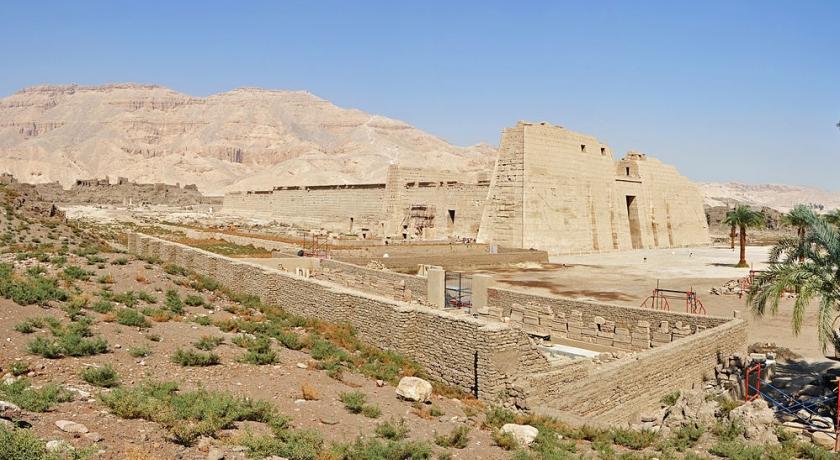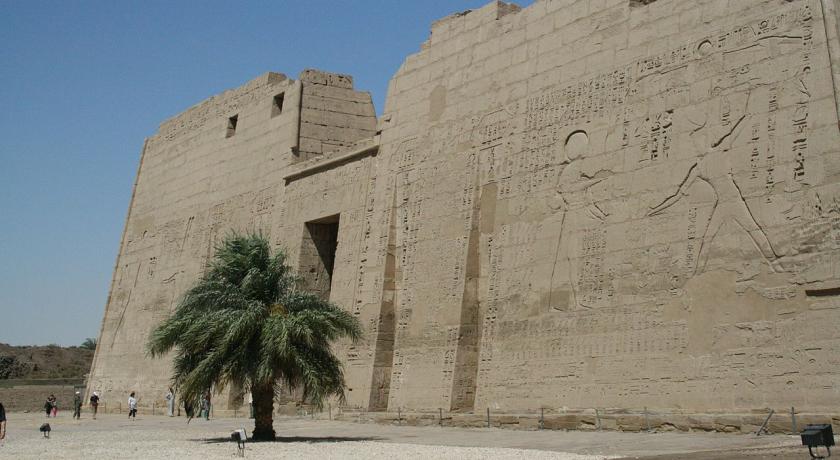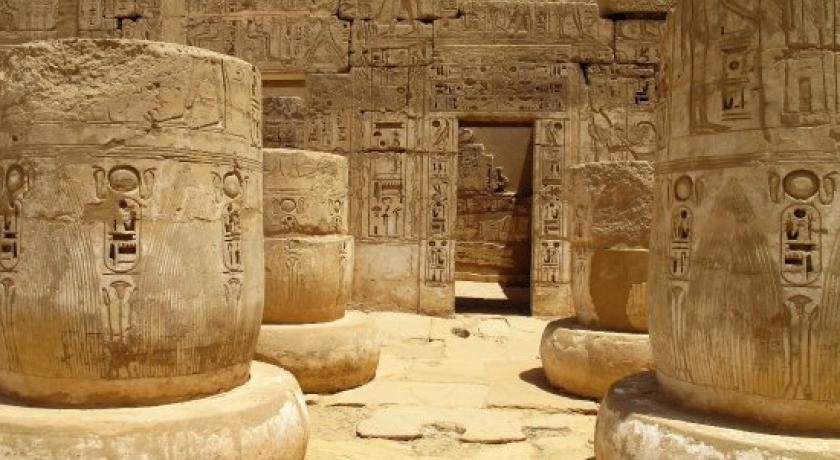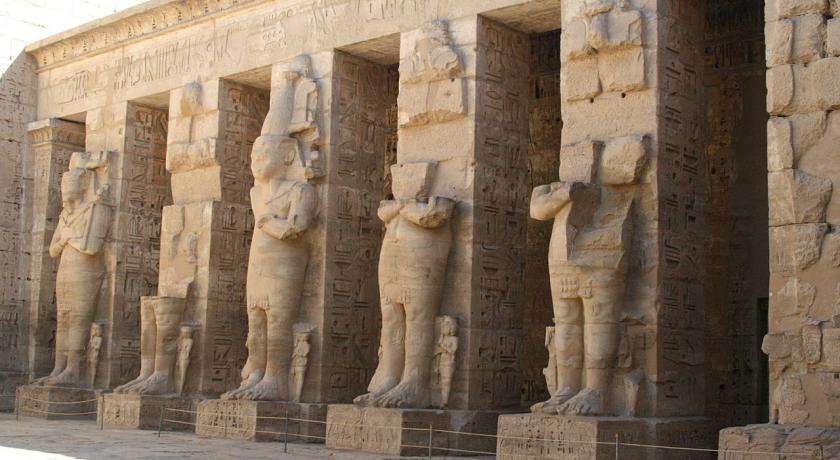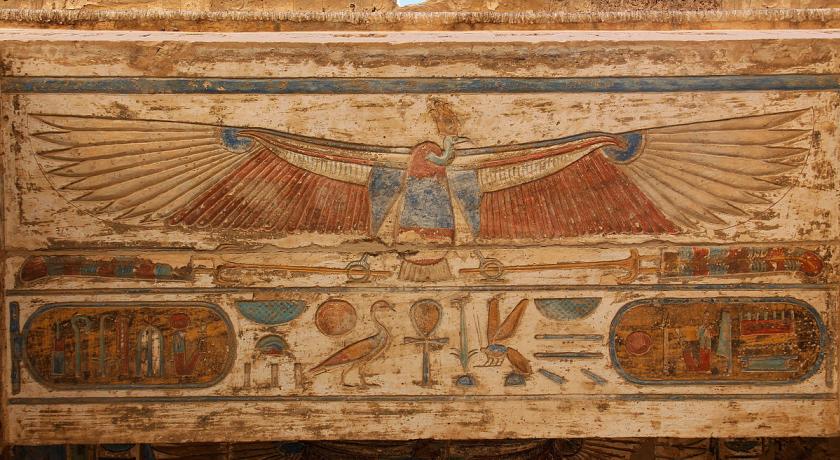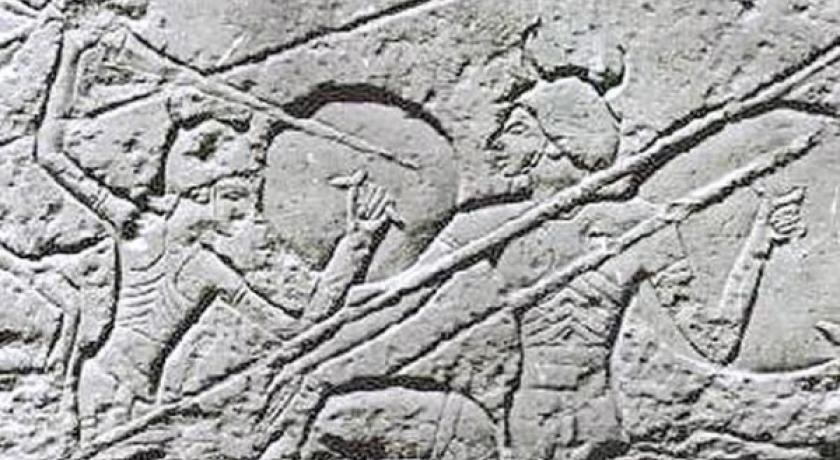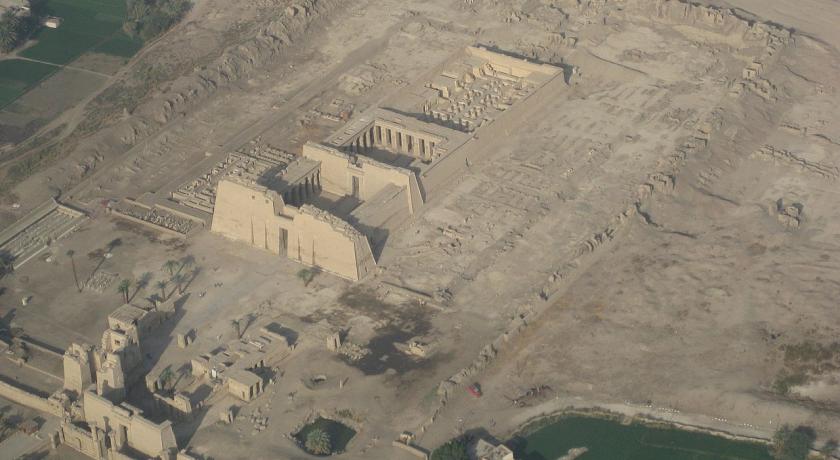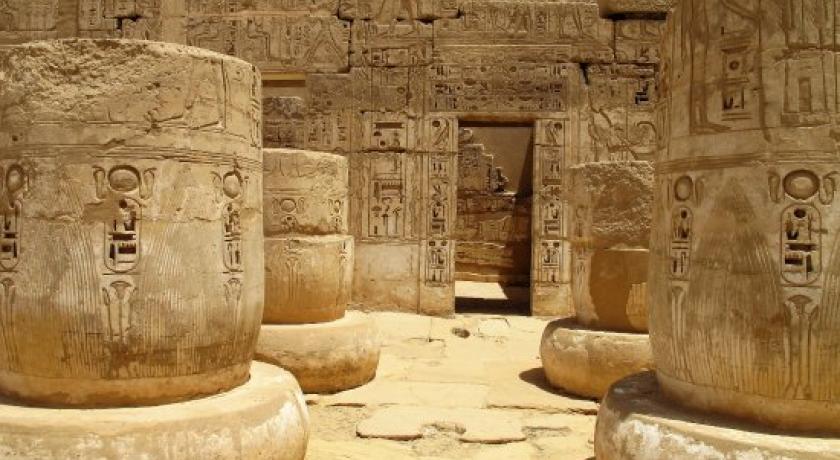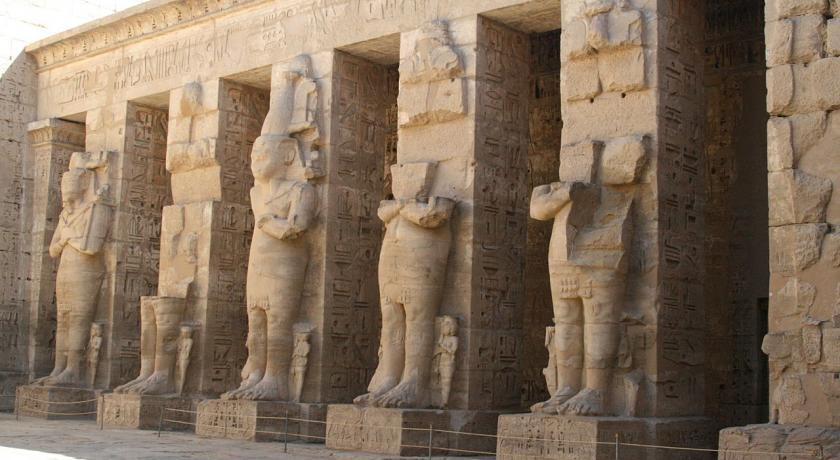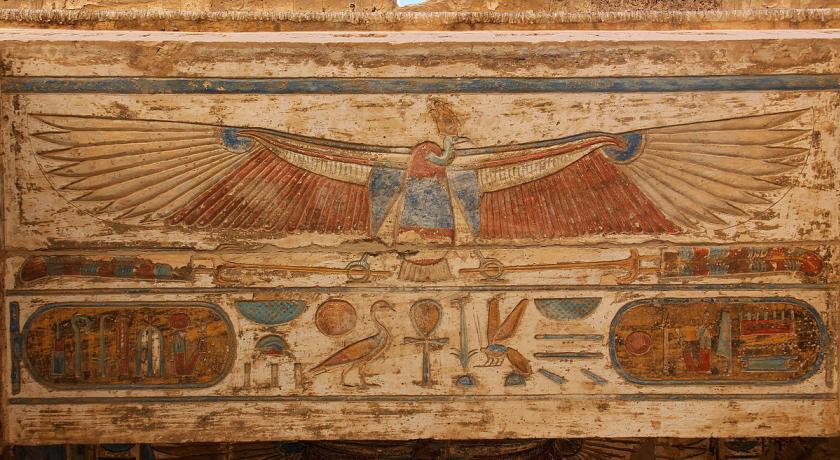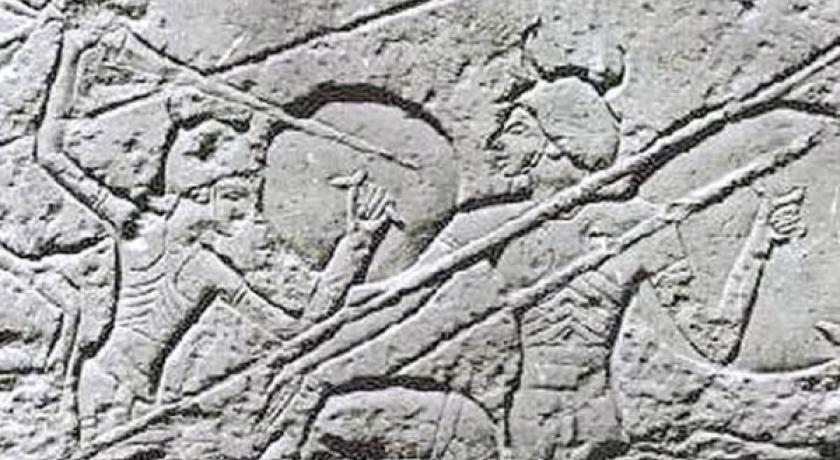0 users like this POI
Description
The temple of the millions of years of Ramses III is a monument dedicated to the worship of this pharaoh. Built at Medinet Habou on the west bank of the Nile, facing Thebes, it was not completely finished until after the death of the sovereign towards - 1154.
Principal enclosure
The temple, one hundred and fifty meters long, is of a common plan, close to the funerary temple of its predecessor, Ramses II. Indeed Ramses III sought to restore the greatness of the Egypt of his illustrious ancestor. Upon his accession to the throne he began to build his Jubilee temple which will remain one of the most extensive in the necropolis of Thebes.
Rather well preserved it is surrounded by an enclosure of mud brick, which may have been fortified and encloses all the monuments of the site. Sign of the times, (Ramses III had to push back in the year five of his reign an invasion of the country), the king decided to guarantee the safety of his Jubilee foundation by a powerful enclosure comprising only two accesses to the west and the 'East.
The original entrance is through a large gate in the East, the migdol, which was designed on the model of the fortified gates of Syrian fortresses and which we have many representations on the reliefs describing the military campaigns of the great conquering pharaohs like Tuthmosis III, Seti I or Ramses II. To the west of the enclosure, symmetrically to migdol, was a second access probably in the same form but of which there remains only the first sitted ones.
The compound includes several sections that houses many monuments and a real city for the staff of the temple and the King's Palace adjoining the main temple.
In the axis of the entrance gate we will find:
-
In the south, the funerary chapels of Amenardis I, Chepenoupet II and Nitocris Ire, all three adorers of Amon;
-
In the north, the temple of Amon de Djemé.
The Temple of the millions of years
The temple of Ramses III adopts a definite plan and which will be the prototype of the great temples of the later periods: two large pylons separating two courts with peristyles, preceding the zone of the sanctuary.
The first entrance, a monumental door framed by the two imposing piers of the great pylon, leads into an open courtyard bordered by two porticoes. The first in the north is composed of pilasters surrounded by massive statues of Ramses III represented in osirian position but dressed in the royal loincloth and wearing a solar corona. The second to the south is composed of papyriform columns with open capitals and forms the royal portico. Indeed the wall includes a "window of apparitions", as well as two doors overlooking a royal palace that is outside the temple. It was to be used by the ruler and the court during the ceremonies that took place here each year during the "Beautiful Feast of the Valley", one of the main festivals of Thebes. Some think that this palace, in view of its rather small size, was only a ritual palace with no other destiny than to play the role of palace for the royal ka. As a result it would have never been used...
Whatever it is, it consists of a hypostyle vestibule, serving as a waiting room, overlooking a courtroom, smaller, with two columns framing a podium on which was to be the throne of the King. Behind this Hall were the Royal apartments with an ante-room, a bedroom and a bathroom. In the east of the vestibule was a corridor leading to a series of adjoining apartments in which one wanted to see the king's harem. In the west of the vestibule was a door leading to a portico bordering a garden with a pond, and overlooking various administrative buildings. This palace is preserved on its first sitting and was reworked during the reign of Ramses III.
The second pylon leads into a second peristyle courtyard in which former royal colossi once stood. All of these courtyards have retained their cover which has protected the frescoes and reliefs of the temple. Thus we can admire deep blue ceilings covered with stars, religious and military scenes on the walls that have kept an extraordinary freshness. In the same way most of the columns have kept their pigments which allows us to have a pretty precise idea of the aspect of a temple in antiquity. Every wall, every column, every ceiling, every cornice, every hieroglyph, everything was painted with bright colors.
This second courtyard gave access through a portico to a third entrance, this time without a pylon, which led to the hypostyle - which has lost its ceiling. Indeed in the year -27, the entire region was the victim of an earthquake which affected most of the monuments of Thebes. Medinet Habou did not escape and the hypostyle hall collapsed. Today, It is now reduced to the first columns sitting, which however remain impressive and is surrounded by a series of chapels that have been restored and retained their painted decorations. The sanctuary also suffered the vicissitudes of history and if we can recognize its location in the axis of the first hypostyle, the naos to him disappeared.
Modern identification and excavation
The first European to describe the temple in modern literature was Vivant Denon, who visited the temple in 1799-1801. Champollion described the temple in detail in 1829.
Initial excavation of the temple took place sporadically between 1859 and 1899, under the auspices of the Department of Antiquities. During these decades the main temple was cleared, and a large number of Coptic period buildings, including a substantial Coptic Church in the second court, were destroyed without notes or records being taken.
The further excavation, recording and conservation of the temple has been facilitated in chief part by the Architectural and Epigraphic Surveys of University of Chicago's Oriental Institute, almost continuously since 1924.
Temple history
The temple of Ramses III became the dynastic temple by excellence. Like the Ramesseum, the king included his descendants and it is likely that the temple served the funerary cult of the successors of Ramses III.
With the anarchy which will follow the end of the 20th dynasty, the temple and its fortified walls served as a refuge for the people of Thebes struggling with incursions of nomads from the western desert and plundered the region during the twenty-first and twenty-second dynasties. At this time we can imagine that the great temples of million years of the ramessides rulers formed fortresses of which Medinet Habou was undoubtedly the most imposing.
In the Late Period, the temple continued to function and the tombs of the divine adorers of Amon were set up in the enclosure of the temple like the royal tombs found in Tanis. The divine worshipers were the royal daughters who devoted themselves to the priesthood of the god Amon and held the office of representing the king at Thebes. They chose to establish their burial as close to the sanctuary of Djemé which remained at that time one of the holy places of the region.
Subsequently with the Greco-Roman monarchs the site was gradually transformed into a city whose main enclosure occupied the center. It is from the very name of Djemé or Djemaï that the Greeks by deformation named the city Thebai, which will later give Thebes, namesake of the Greek Thebes.
The city remained concentrated around the site and during the Coptic period, a church, which was later removed, was installed in the second courtyard of the temple of Ramses III. Coptic engravers have also deteriorated the engravings Egyptian and drawings on the columns, and you could still see the columns with Corinthian capitals which supported the roof of the Christian Church in the early 20th century.
At the end of Antiquity, and with the Arab invasion, the site was gradually abandoned and covered by mounds of rubble.
Source: https://fr.wikipedia.org/wiki/Temple_des_millions_d%27ann%C3%A9es_de_Rams%C3%A8s_III
Address
Luxor
Egypt
Lat: 25.719312668 - Lng: 32.601341248



